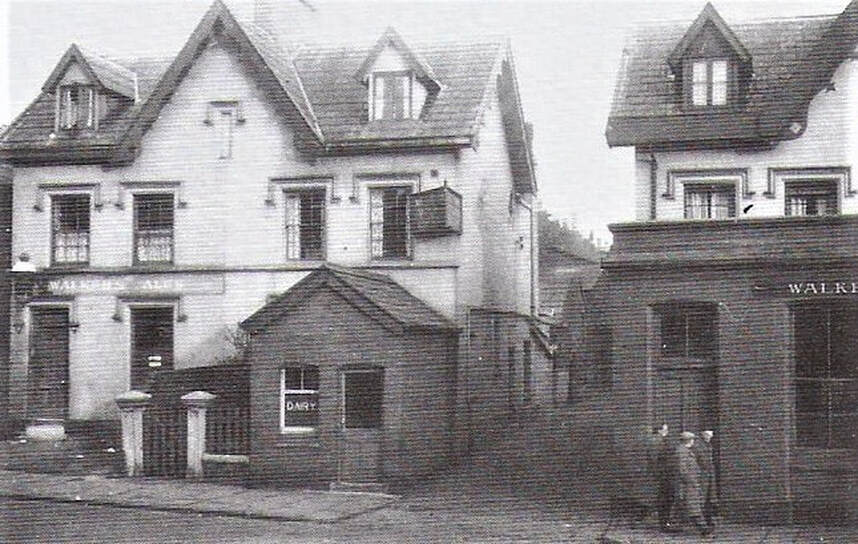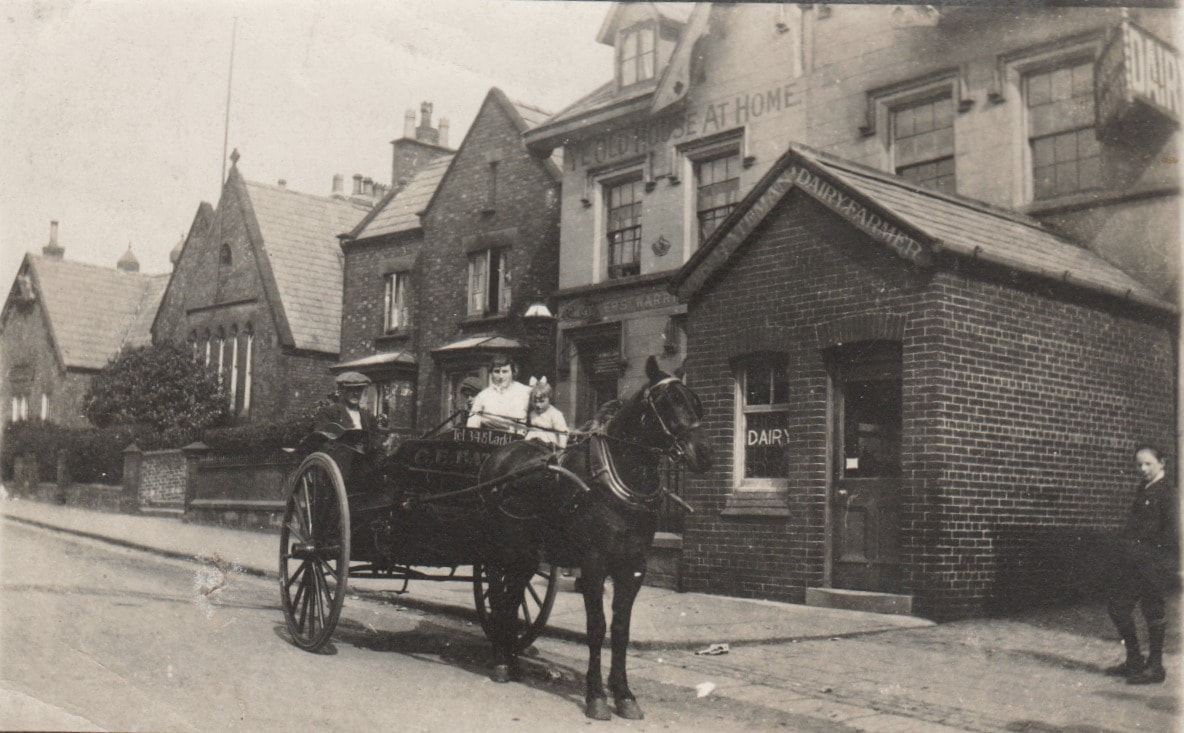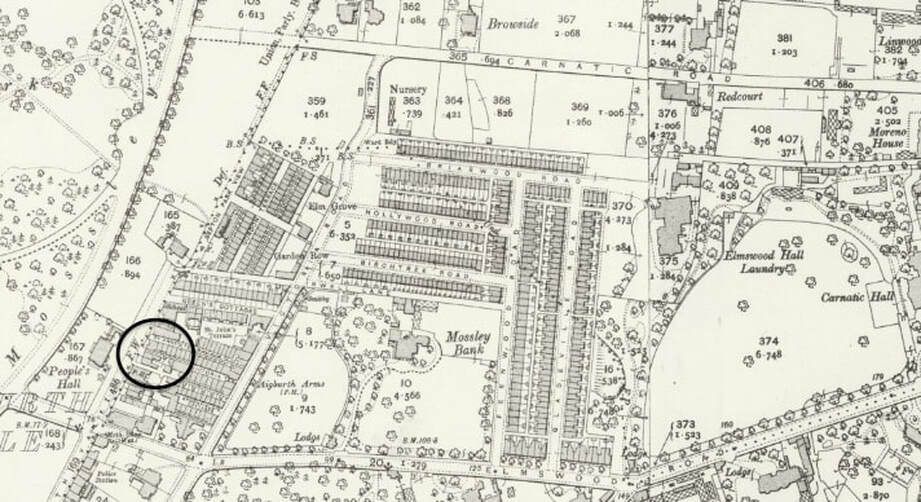It was way back in December 2018, after a talk I gave to Kirkby Lonsdale Civic Society, that James German got in touch to tell me about his great grandfather, also James German, who had been a cowkeeper in Liverpool. James also sent me a two-page extract from a memoir written by Matt Braithwaite, a Liverpool cowkeeper originally from the Kirkby Lonsdale area. Unfortunately, due to an extended period of illness on my part, I lost contact with James. The extract I held did not include any publication details, not even the title, and so surfing the Internet in order to identify it proved to be fruitless. Then, some four years later, a chance exchange of emails with Mike Chitty of the Wavertree Society, revealed that he had a digital copy of the said publication. Mike had acquired his copy from one John Harper, whose family had been cowkeepers in Wavertree and who were mentioned in the book. So, thanks to James, John and Mike for sharing.
The book is titled Many Happy Returns, by Matthew Braithwaite. The reason it was so difficult to track down is that it was never published, but was printed for the author’s personal use in 1949. Presumably, there aren't that many copies in existence. Which is a great pity, as it is an entertaining and informative account of Matt’s life: growing up to be a dairy farmer in Lunesdale, spending twenty years keeping cows in Liverpool, and then returning to the countryside in retirement. Of obvious interest to me is the chapter describing Matt’s time in Liverpool, from 1921 until 1941, which is packed with intriguing detail of the cowkeeping way of life. It also includes an account of the Cowkeepers’ Association’s holiday to Switzerland, which I had previously heard mention of, but was beginning to think was just a myth.
So, here is a brief summary of Matthew’s family history together with an abridged version of his account of life as a Liverpool cowkeeper.
The book is titled Many Happy Returns, by Matthew Braithwaite. The reason it was so difficult to track down is that it was never published, but was printed for the author’s personal use in 1949. Presumably, there aren't that many copies in existence. Which is a great pity, as it is an entertaining and informative account of Matt’s life: growing up to be a dairy farmer in Lunesdale, spending twenty years keeping cows in Liverpool, and then returning to the countryside in retirement. Of obvious interest to me is the chapter describing Matt’s time in Liverpool, from 1921 until 1941, which is packed with intriguing detail of the cowkeeping way of life. It also includes an account of the Cowkeepers’ Association’s holiday to Switzerland, which I had previously heard mention of, but was beginning to think was just a myth.
So, here is a brief summary of Matthew’s family history together with an abridged version of his account of life as a Liverpool cowkeeper.
Matthew Braithwaite (1874-1953)
Matt was one of five children of Matthew Braithwaite (1840-1921) and Mary Ann Atkinson (1844-1912), who farmed 190 acres at Belle Vue Farm, Kirkby Lonsdale. On 4th April, 1899, he married Agnes Richardson (1872-1950), the daughter of Thomas and Jane Richardson, of Sowermire Farm, Middleton. To begin with, Matt and Agnes farmed at Durham House, but when Thomas Richardson retired, in 1905, they moved to Sowermire Farm. They had five children: Isabel (1901-1987), Hena Richardson (1902-1982), Matthew jnr. (1906-1986), Agnes Jean (1910-1979) and Margaret (1916-1979). Matt’s memoir describes the family’s life and times after they relocated to Liverpool.
Matt was one of five children of Matthew Braithwaite (1840-1921) and Mary Ann Atkinson (1844-1912), who farmed 190 acres at Belle Vue Farm, Kirkby Lonsdale. On 4th April, 1899, he married Agnes Richardson (1872-1950), the daughter of Thomas and Jane Richardson, of Sowermire Farm, Middleton. To begin with, Matt and Agnes farmed at Durham House, but when Thomas Richardson retired, in 1905, they moved to Sowermire Farm. They had five children: Isabel (1901-1987), Hena Richardson (1902-1982), Matthew jnr. (1906-1986), Agnes Jean (1910-1979) and Margaret (1916-1979). Matt’s memoir describes the family’s life and times after they relocated to Liverpool.
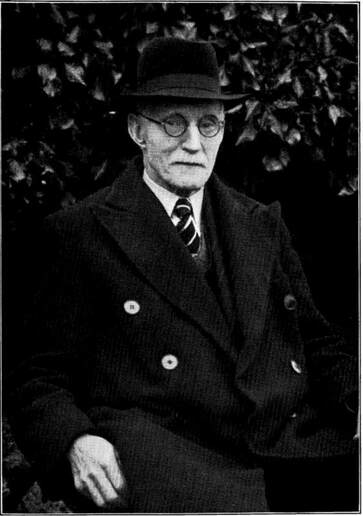 Matthew Braithwaite, 1949.
Matthew Braithwaite, 1949.
'Many Happy Returns' — The unpublished memoir of Matthew Braithwaite.
Extract from Chapter 2: “High Noon” — Liverpool, 1921-1941.
“When we were preparing to leave Sowermire Farm and were looking round for another, Mr RICHARD HARPER asked me one day if I would be interested in a retail dairy farm in Liverpool. I said I might be, provided it was not in the centre of the City. He knew that one of the best dairy farms in the suburbs of Liverpool was for sale and we arranged to go over the next day, Mr Harper taking us in his car. My wife and I were so attracted by the place that we immediately completed the purchase by paying a deposit and we were on our way home again before 5pm. This business proved a very sound investment even if we did have to work hard. Farming in the country was certainly an easier life, but we received a better return for our labours in the town. In addition to our premises, we rented two good fields, to which we added a little later the ten-acre park of Carnatic Hall, a large residence nearby; all these provided some excellent grazing for our cattle in the summer. For his helpfulness on this occasion we shall ever feel grateful to Mr Richard Harper.
In March 1921 we took possession of Aigburth Vale Dairy Farm, which was situated in the suburbs at the south end of Liverpool, adjoining Sefton Park. Here we retailed daily approximately seventy gallons of milk during the winter months and up to one hundred gallons throughout the summer. It was an excellent business, situated as it was amongst wealthy customers in Sefton Park, Fulwood Park and Mossley Hill. Among those customers I recall were The Lord Bishop of Liverpool, Sir Max Muspratt, Mrs Rathbone (Chairman of the Liverpool Children’s Welfare Committee), W B Stoddart Esq., Stanley Cohen Esq. (Director of Lewis’s Ltd.), J C Wilson Esq. (Chairman of Liverpool Tramways Dept.), Mrs Blackler (of Blackler’s Stores Ltd.), Mrs Thompson (of the firm of Thompson and Capper Ltd. Manufacturing Chemists), and the Aigburth Vale High School for Girls. During the summer when the weather was suitable there were frequent queues from the Tennis clubs in Sefton Park to keep us very busy in the Dairy.
Once in Liverpool I was no longer a stock-breeding farmer but specialised in milk production. I found by experience the following diet the most successful for maintaining the milk supply and for keeping the cattle really fit. The first essential is good hay with all its seeds on it. Our hay dealer used to supply us with South Country hay, very often from Lincolnshire. I could have bought local hay grown within two miles of Liverpool on black peaty land, nearly £2 per ton cheaper, but the good South Country June hay has nearly as much more milk in it. To supplement the hay, we found that the addition of brewers’ grains and molasses added to the yield of milk; and last but not least was the labour-saving device of automatic drinking bowls which encouraged the cows to drink more frequently and added to the quantity of milk.
Extract from Chapter 2: “High Noon” — Liverpool, 1921-1941.
“When we were preparing to leave Sowermire Farm and were looking round for another, Mr RICHARD HARPER asked me one day if I would be interested in a retail dairy farm in Liverpool. I said I might be, provided it was not in the centre of the City. He knew that one of the best dairy farms in the suburbs of Liverpool was for sale and we arranged to go over the next day, Mr Harper taking us in his car. My wife and I were so attracted by the place that we immediately completed the purchase by paying a deposit and we were on our way home again before 5pm. This business proved a very sound investment even if we did have to work hard. Farming in the country was certainly an easier life, but we received a better return for our labours in the town. In addition to our premises, we rented two good fields, to which we added a little later the ten-acre park of Carnatic Hall, a large residence nearby; all these provided some excellent grazing for our cattle in the summer. For his helpfulness on this occasion we shall ever feel grateful to Mr Richard Harper.
In March 1921 we took possession of Aigburth Vale Dairy Farm, which was situated in the suburbs at the south end of Liverpool, adjoining Sefton Park. Here we retailed daily approximately seventy gallons of milk during the winter months and up to one hundred gallons throughout the summer. It was an excellent business, situated as it was amongst wealthy customers in Sefton Park, Fulwood Park and Mossley Hill. Among those customers I recall were The Lord Bishop of Liverpool, Sir Max Muspratt, Mrs Rathbone (Chairman of the Liverpool Children’s Welfare Committee), W B Stoddart Esq., Stanley Cohen Esq. (Director of Lewis’s Ltd.), J C Wilson Esq. (Chairman of Liverpool Tramways Dept.), Mrs Blackler (of Blackler’s Stores Ltd.), Mrs Thompson (of the firm of Thompson and Capper Ltd. Manufacturing Chemists), and the Aigburth Vale High School for Girls. During the summer when the weather was suitable there were frequent queues from the Tennis clubs in Sefton Park to keep us very busy in the Dairy.
Once in Liverpool I was no longer a stock-breeding farmer but specialised in milk production. I found by experience the following diet the most successful for maintaining the milk supply and for keeping the cattle really fit. The first essential is good hay with all its seeds on it. Our hay dealer used to supply us with South Country hay, very often from Lincolnshire. I could have bought local hay grown within two miles of Liverpool on black peaty land, nearly £2 per ton cheaper, but the good South Country June hay has nearly as much more milk in it. To supplement the hay, we found that the addition of brewers’ grains and molasses added to the yield of milk; and last but not least was the labour-saving device of automatic drinking bowls which encouraged the cows to drink more frequently and added to the quantity of milk.
Immediately after settling down at Aigburth Vale, we started exhibiting dairy cattle, not merely because it was my hobby but also because the advertisement which it brought to us increased our sales of milk. We achieved great success at a number of shows including: Liverpool and Prescot Agricultural Show, Crewe Shorthorn Cattle Show, The Royal Lancashire Show, Liverpool Christmas Dairy Show, Chester Show etc. Not only have I exhibited cattle in all parts of Lancashire and Westmorland, but I have also been invited often to be one of the judges in the same area. The appointment, however, which gave me the greatest pleasure was that of being one of the two judges, the other being Mr J. T. Bellas of Penrith, at the Liverpool and District Christmas Dairy Show in 1945. One of the finest shows in the north of England, nearly all the winners of the country shows meet there to share sixteen Silver Cups and over £500 in prize money each year for Dairy and Fat Cattle.
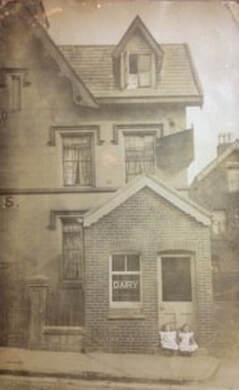 Two Little Maids!
Two Little Maids!
Curiously enough, the people from whom we bought Aigburth Vale Dairy, Mr and Mrs CHARLES E BATEMAN, hailed from Westmorland and on leaving Liverpool returned there to take a farm. As soon as the Bateman family had left the Vale, a dairy farmer who was in business about two miles away came and introduced himself. What a pleasant surprise and welcome it was! He told us he was HARRY WINN, that he and his wife, natives of Howgill, farmed there before they came to Liverpool and that their relations were still farming in that district. Harry at once made a very friendly gesture: “I will call on you every day for a few minutes and help you to make a start in the retail side of the milk business, since it will all be new to you.” And what a help he was, and Mrs Winn as well! Mr and Mrs Winn were kind, honest and reliable neighbours with whom we interchanged visits regularly all the time we were in Liverpool — we shall never forget the great help and delightful company they always were to us.
Another family of dairy farmers who became great friends of our was that of Mr and Mrs RICHARD TAYLOR, of Otterspool Farm, Grassendale. Now retired from business they have taken up residence in Kirkby Lonsdale, close to their native haunts, and I frequently meet Dickey at the Kirkby Lonsdale Auction Mart, where we can still find plenty to remind us of Liverpool days. Mr and Mrs GEORGE INGHAM and their three sons and a daughter were also friends of our while we were at the Vale. George was a cattle dealer from whom I often bought cows.
Every year the Dairy Farmers and Cowkeepers of Liverpool had two very enjoyable evenings, which were very popular, the one a Whist Drive and Dance, the other a Dinner at the Adelphi Hotel. The latter was originally “For Men Only” but it was eventually invaded by the ladies who enjoyed themselves every bit as much as their menfolk.
After we had spent four arduous years in learning the milk retailing business and developing its size, my wife and I thought we had earned a good holiday, especially as our own family were quite competent to carry on for a week or two without us. Thus, we joined an excursion to Switzerland arranged by the Cowkeepers’ Association in collaboration with Cook’s Tours. My wife and I remember this as the finest holiday we have ever had for health, for entertainment and for marvellous scenery. On these tours everything is arranged for the travellers, with a different programme for each day — and what a thrilling interesting programme it was!
We reached Lucerne, our headquarters, by train to Dover, boat to Boulogne and then by train through the battlefields of Northern France until we finally arrived at our destination, the Royal Hotel. Although the weather was delightful, we were surprised to find the farmers all haymaking, though it was only mid-May. The next day we went up the Alps on open rack-railway cars. When we arrived at the summit of Pilatus, 6,998 feet above sea-level, it was snowing, but the snowdrifts had been cut through to enable us to go into the hotel for lunch. What a difference from the hayfields and the sunshine we left round Lucerne in the morning! Other excursions we made were to Engelberg, on the way to which we saw many cattle with bells strapped to their necks, to Andermatt, where, as we travelled up the Alps, we saw the glaciers on each side of the railway, and to Fluelen, whither we went by steamer on several occasions.
On our return journey we were able to spend a day sightseeing in Paris where the shops exercised a fatal fascination over the ladies! The menfolk, not so vitally interested in shopping, visited one of the hotels in search of a reviver. From Paris we journeyed to London, where we spent another whole day visiting the Wembley Exhibition, finishing up with much enjoyment in the Pleasure Fair there. Eventually we arrived home after a perfectly delightful holiday. Not the least enjoyable part of our excursion was the company with which we holidayed and which included HARRY and Mrs WINN, JOHN and Mrs MOORE, BILLY HERD, STANLEY and Mrs FOSTER, JOHN and Mrs HOGG, FAWCETT and Mrs HARPER, and BOB BATTY, among many more of our friends.
In work, in friendship and in play, the years passed on in Liverpool till the strain of long hours and hard work began to tell on us somewhat. As a result, we sold the dairy farm to Messrs ARCHER & SOMMERSCALES, whom we grew to know well and appreciate, and bought a house (to which we gave the only name possible — Lunesdale) on the Boulevard, from where all our children, except Isabel and Jean, were married.
So twenty long years passed by in Liverpool — years that had seen us grow older — that had seen our family grow up and all marry except one, whose marriage, delayed by the war, took place shortly after our return to Barbon. We had planned to spend the rest of our lives in the big city that had been our home for that twenty years. Man proposed, but in this case, Hitler disposed . . . After enduring the blitz of the German bombers on Merseyside, we decided, since it was not essential for us to stay, to evacuate to our native heath. After the rush of the big city, the peace of the countryside, the grandeur of the hills and the kindliness of many friends of many years before have brought us much happiness in this, our last lap.”
Pride in Prizes
Matt was very proud of his many successes in exhibiting his cows at shows, both in Westmorland and in Lancashire. His memoir includes an appendix of the awards of which he had kept a record. I have supplemented this with information from the newspaper archives. Listed below are some of his prizes whilst keeping cows in Liverpool:
1922
Liverpool Christmas Dairy Show — Two second prizes for dairy cows.
1923
Royal Lancashire Show — Second Prize (£4) to M. Braithwaite, Aigburth Vale.
1924
Liverpool Christmas Dairy Show — In the class for calved cows over 10½cwt., Mr M. Braithwaite, Aigburth Vale, was first with the Kirkby Lonsdale Show champion.
Ormskirk Agricultural Show — First Prize and Champion for Dairy Cows.
Woolton Agricultural Show — two first prizes for dairy Cows.
Preston Christmas Dairy Show — First Prize for Dairy Cows. Winner of 14-guinea Rose Bowl.
1925
Prescot and District Agricultural Show — First Prize in open class. First Prize in local class. Hornby Challenge Cup, value five guineas. The Grace Cup. Messrs Simmonds, Hunt and Montgomery’s Cup. Messrs Toogood and Sons’ Solid bronze Plague.
1926
Liverpool Christmas Dairy Show — Four First Prizes for Dairy Cows, Reserve for Champion Dairy Cow, Reserve for 25-guinea cup.
Ormskirk Agricultural Show — First Prize for Dairy Cows.
Matt was very proud of his many successes in exhibiting his cows at shows, both in Westmorland and in Lancashire. His memoir includes an appendix of the awards of which he had kept a record. I have supplemented this with information from the newspaper archives. Listed below are some of his prizes whilst keeping cows in Liverpool:
1922
Liverpool Christmas Dairy Show — Two second prizes for dairy cows.
1923
Royal Lancashire Show — Second Prize (£4) to M. Braithwaite, Aigburth Vale.
1924
Liverpool Christmas Dairy Show — In the class for calved cows over 10½cwt., Mr M. Braithwaite, Aigburth Vale, was first with the Kirkby Lonsdale Show champion.
Ormskirk Agricultural Show — First Prize and Champion for Dairy Cows.
Woolton Agricultural Show — two first prizes for dairy Cows.
Preston Christmas Dairy Show — First Prize for Dairy Cows. Winner of 14-guinea Rose Bowl.
1925
Prescot and District Agricultural Show — First Prize in open class. First Prize in local class. Hornby Challenge Cup, value five guineas. The Grace Cup. Messrs Simmonds, Hunt and Montgomery’s Cup. Messrs Toogood and Sons’ Solid bronze Plague.
1926
Liverpool Christmas Dairy Show — Four First Prizes for Dairy Cows, Reserve for Champion Dairy Cow, Reserve for 25-guinea cup.
Ormskirk Agricultural Show — First Prize for Dairy Cows.
1927
Liverpool Christmas Dairy Show — Four first prizes and Championship in middle-weight class. The Metcalf Shield. Reserve: M Braithwaite.
Preston Christmas Dairy Show — First Prize and Championship.
Royal Lancashire Agricultural Show — First prize for best dairy cow in milk, heavyweight, open UK. First prize for best Dairy Cow in Milk, any weight, in Lancashire. First prize for best Dairy Cow in Milk in Lancashire Farmers’ Class, any weight or breed in Milk. Fourth prize in the milking trials (£26 in prize money).
1928
Liverpool Christmas Dairy Show — Cows (calved) exceeding 11cwt. 2nd place M Braithwaite, Liverpool. Best Cow in Calf or Milk (members only). 3rd place: M Braithwaite, Liverpool.
1929
Liverpool Christmas Dairy Show — Fat Cows (under 14cwt). 3rd place: M Braithwaite. Fat Cows which have not won a prize in open competition. Under 14cwt. 1st place: M Braithwaite. Best Cow in calf. 3rd place: M Braithwaite.
Prescot & District Agricultural Show — “I repeated my success of 1925 by gaining all the first four prizes and winning the two cups outright and the bronze plaque and championship.”
Chester Show — First prize for dairy Cows.
1930
Liverpool Christmas Dairy Show — President’s Prize awarded to M Braithwaite.
Liverpool Christmas Dairy Show — Four first prizes and Championship in middle-weight class. The Metcalf Shield. Reserve: M Braithwaite.
Preston Christmas Dairy Show — First Prize and Championship.
Royal Lancashire Agricultural Show — First prize for best dairy cow in milk, heavyweight, open UK. First prize for best Dairy Cow in Milk, any weight, in Lancashire. First prize for best Dairy Cow in Milk in Lancashire Farmers’ Class, any weight or breed in Milk. Fourth prize in the milking trials (£26 in prize money).
1928
Liverpool Christmas Dairy Show — Cows (calved) exceeding 11cwt. 2nd place M Braithwaite, Liverpool. Best Cow in Calf or Milk (members only). 3rd place: M Braithwaite, Liverpool.
1929
Liverpool Christmas Dairy Show — Fat Cows (under 14cwt). 3rd place: M Braithwaite. Fat Cows which have not won a prize in open competition. Under 14cwt. 1st place: M Braithwaite. Best Cow in calf. 3rd place: M Braithwaite.
Prescot & District Agricultural Show — “I repeated my success of 1925 by gaining all the first four prizes and winning the two cups outright and the bronze plaque and championship.”
Chester Show — First prize for dairy Cows.
1930
Liverpool Christmas Dairy Show — President’s Prize awarded to M Braithwaite.
Aigburth Vale Dairy Farm
The trade directories of the day record this property as 16 AIGBURTH VALE. It was a semi-detached property, with the dairy at number 16 and a public house — Ye Olde House at Home — at number 17; at number 15 was another pub, The Traveller’s Rest. To the rear of the main house was a large yard and a number of outbuildings, including a shippon where the cows were kept during the winter. Matt describes it as being located opposite The People’s Hall, where he used to play bowls. The property has a long history of use as a dairy as indicated by entries in the census records and trade directories:
1861 — George Batterley, Milk House (b. Bangor, Denbighshire)
1871 — Edward Ryder, Cowkeeper (b. Leyburn, Yorks.)
1881 — Edward Ryder, Cowkeeper (b. Coverdale, Yorks.)
1891 — Thomas Wilson, Farmer (b. Howgill, Yorks.)
1901 — Charles E Bateman, Farmer and Cowkeeper (b. Firbank, Westmorland.)
1926 — Matthew Braithwaite, Dairyman
1938 — Archer & Summerscales, Dairymen
1955 — Archer & Summerscales, Dairymen
The dairy was ideally situated. It had easy access to a local customer base consisting of an interesting mix of the terraced properties of the working-class of Aigburth and the grand, detached homes of the well-to-do of Sefton Park and Fulwood Park. It also had easy access to nearby fields on Mossley Hill Drive for grazing the cows during summer. Matt was able to add to this resource when he rented the 10-acre park at Carnatic Hall (on the right hand side of the map, above), accessible from the dairy along Briarwood Road.
Eddie Bentley:
“I lived in Gladeville Road from 1947, and remember well the cows being driven up Briarwood Road to the field behind our house, where University Halls of Residence are now. Great source of manure for local gardeners.”
Paul Wildman:
“My mother told me that when she moved into her house in Briarwood Road (off Victoria Road in Aigburth) in 1950, a dairyman used to drive his cows up the road to fields at the top of Briarwood Road, where university residences were built later.”
Despite some major redevelopment in the area, the building still stands today, though the single-storey frontage of the dairy was removed when it was converted into luxury flats (now Travellers Court).
